82 Search Results for motivation
January 12, 2013
by Carole Zangari -
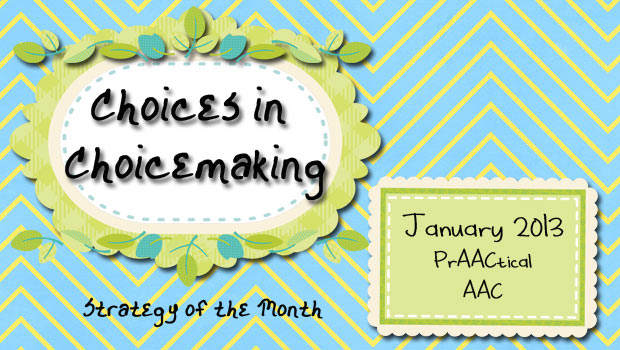
Choicemaking and requesting may be the most frequently targeted areas for beginning communicators who are starting out with their AAC systems. That makes sense for some learners because making choices is a very concrete focus for interaction and is loaded with motivational power. It seems pretty straightforward but, like anything else we do clinically, there are lots of decisions and choices to be made as we delve deeper into the process. How can we craft an AAC system that targets requesting for now, but also supports core language learning? For communicators who are at the earliest stages of making requests with AAC symbols, the strategy we discussed earlier this month or simple choice boards are a good starting point. But unless we quickly address where this is all going, the client will be strictly limited in their language learning. There are many ways to do this. Here is one approach.... [Read More...]
January 10, 2013
by Carole Zangari -
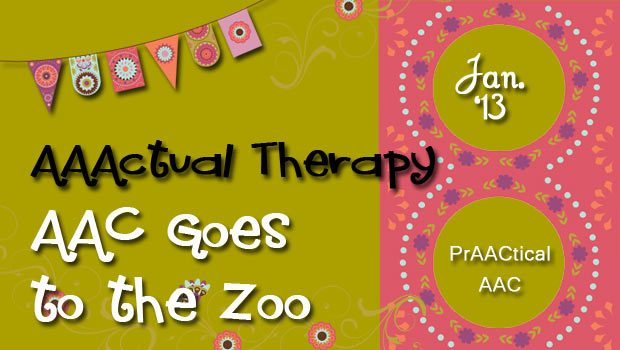
Welcome to AACtual Therapy, a new series on PrAACtical AAC that we’re undertaking in order to give you an up-close-and-personal look at SLPs who ‘do’ AAC. Each of these posts will feature one of our prAACtical friends, some of whom have been AAC interventionists for awhile and others who have come to it more recently. Each one is passionate about giving people a voice no matter what their age or ability level. They’ll be giving us a peek into an AAC therapy lesson that they use, and telling us about the strategies that make it successful. They’ll share a bit about the goals and objectives the lesson was designed to address, and what sorts of AAC their clients are using. Hopefully, we’ll see them in action Here’s what NOT to expect: Perfection. It doesn’t exist, so we don’t even bother looking for it. We’re featuring these clinicians because we want... [Read More...]
January 9, 2013
by Robin Parker -
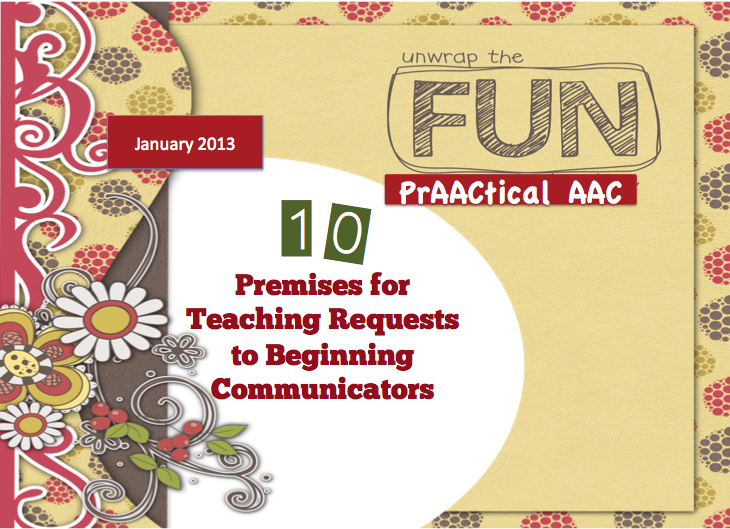
Requesting is a communication skill that is often a fun goal to target because the end result should be ‘giving’ the learner what they want. Here are some underlying premises when teaching requests: The learner LOVES or places IMPORTANCE on what they are requesting The facilitator may need to LOOK for & ACCEPT what the learner prefers MOTIVATION and INTEREST can be TAUGHT with frequent and varied practice in predictable routines Communication temptations give requesting more CLARITY for the learner Learners can request WITHOUT being asked a question (in fact, it helps with spontaneity) Requests can be facilitated through CHOICE MAKING Requests and choices GO WAY BEYOND food & objects The facilitator can MODEL requesting and choice making and then give the learner a turn There can be monthly, daily, hourly, minute, or even second CHANGES in preferences, motivations, and interests Frequent OPPORTUNITIES for requests and choices are the key... [Read More...]
December 22, 2012
by Robin Parker -
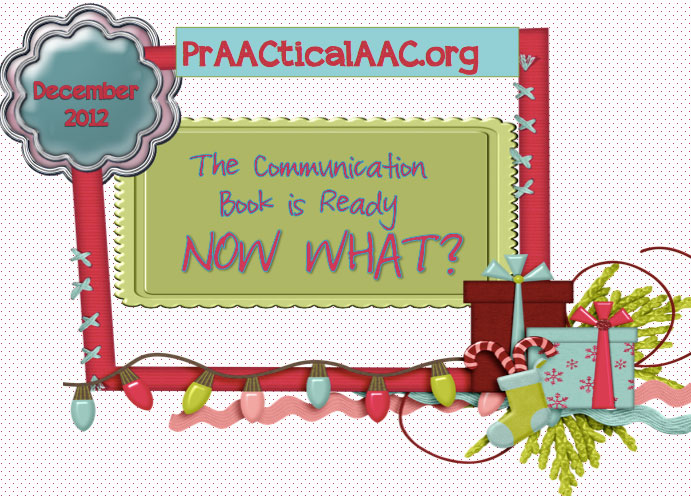
The Communication Book is Ready… Now What? The fun begins…. Yes, we really do think that TEACHING a learner to USE the communication book is FUN. We get to participate in lots of meaningful language experiences, we get to be creative, we get to watch language blossom, and we get to be surprised by the communication competence ALL of our learners show us after prAACtice, prAACtice, and for some more prAACtice . The best way to get started with communication book teaching is to begin by trying out different teaching tips, strategies, and resources and find out what works best. Each communication dyad (communicator & communication partner) is different so the combination of strategies that will work will vary but at the core of the teaching process, there should be fun, motivation, and of course progress. STRATEGIES and CONSIDERATIONS Aided Language Input (ALI)– We can not say enough about... [Read More...]
December 8, 2012
by Robin Parker -
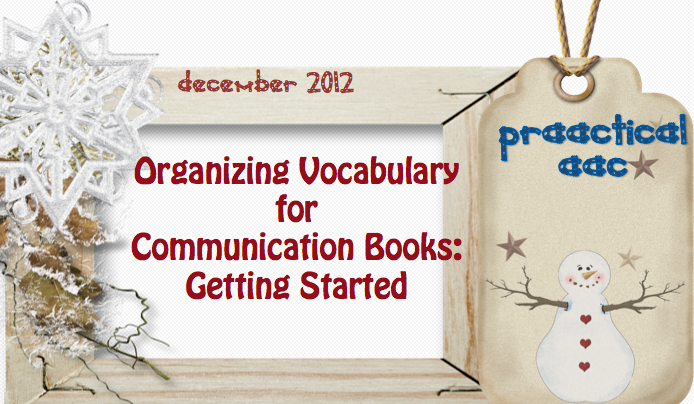
Organizing vocabulary on communication boards sometimes feels overwhelming, especially if you have not had specific training or education in this area. It is a huge responsibility because if the communicator can not navigate the communication book easily and quickly they might ‘lose’ motivation or ‘lose’ a listener. A problem that often occurs in ordering vocabulary for a communication book is that there appears to have been no plan. And when there are no plans, disorganization usually occurs and with disorganization comes chaos. So to avoid chaos, it is very helpful to make long term plan. Long Term Plan Considerations- A Beginning: Language Learning– it is often helpful to order vocabulary on a communication display so that the communicator can learn language and literacy in addition to functional communication. With this in mind, core and fringe vocabulary can be organized in a way that follows a left to right access to... [Read More...]
November 24, 2012
by Robin Parker -
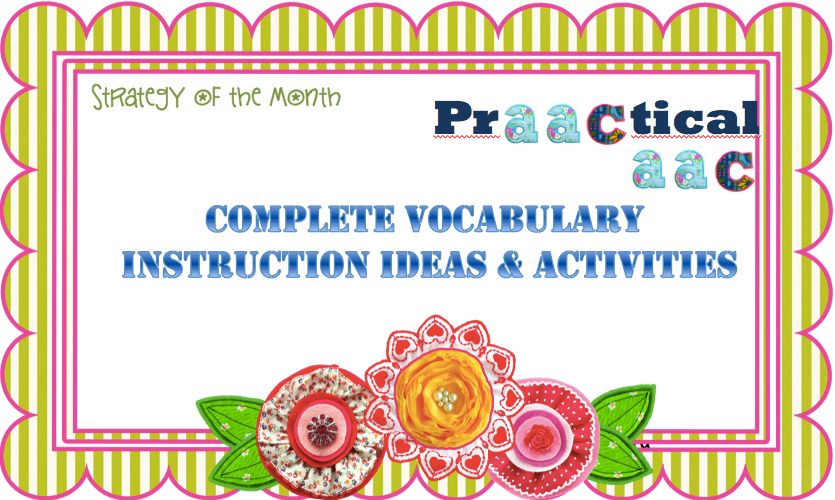
We love incorporating new vocabulary into fun motivating activities even when we are doing direct vocabulary instruction. We embed new vocabulary in activities using all of the language modalities- reading, writing, talking, and listening. We use planned vocabulary instruction activities as well as unexpected opportunities to embed new vocabulary. We like to stay within the theme of vocabulary learning but try and stay flexible in case a perfect opportunity arises that allows us to reflect back on an old vocabulary theme or mention a future planned theme. The main goal of direct vocabulary instruction is more than learning a new list of words, it is learning robust word knowledge so that language skills can be broadened. Consider these vocabulary instruction steps by Robert Marzano. These steps were not specifically developed for AAC users but if we add a language focus and a little more fun and active participation, they... [Read More...]
November 2, 2012
by Carole Zangari -
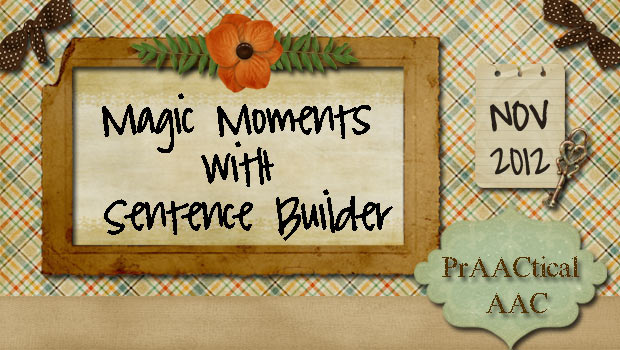
We were lucky enough to snag copies of Sentence Builder by AbiTalk when it was offered for free earlier this year and have had a great time with it. It comes with prepared lessons at two levels and the flexibility to create your own lessons. Here are some ideas for using the ready-made lessons to build language skills in AAC learners. Core Vocabulary: We’re always looking for ways to practice an initial lexicon of basic core words, like I, is, have, and can. These words appear with frequency in Sentence Builder, which makes it a great fit for learners working on that skill. Those of you using this app in a group may find that this offers a great opportunity for differentiating instruction in multi-level groups. Parts of Speech: In AAC therapy, we often focus on the part of speech since that it how many SGDs organize vocabulary. We like... [Read More...]
October 9, 2012
by Carole Zangari -
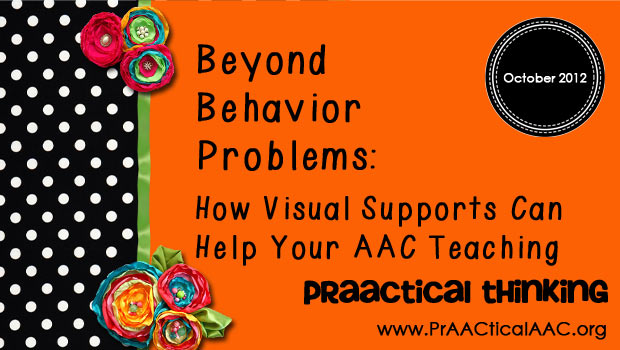
Visual supports are not just for people with behavioral challenges. In this post, we share some ideas of using visual schedules and other supports to enhance comprehension and language learning. Let’s look put this into a clinical context. Marvin is a high school student with intellectual disabilities and cerebral palsy who is learning to use a high tech SGD. He is a personable young man who engages easily and comes to each session with a ‘ready to learn’ mindset. Most of Marvin’s goals revolve on learning to build sentences using core words. Although he has very limited literacy skills, he really, really wants to learn word prediction. This presented a bit of a dilemma, as I typically don’t begin to teach word prediction until spelling skills are approaching the third grade level. Marvin has some terrific splinter skills but his overall spelling skills are probably around the mid-first grade level.... [Read More...]
March 12, 2012
by Robin Parker -
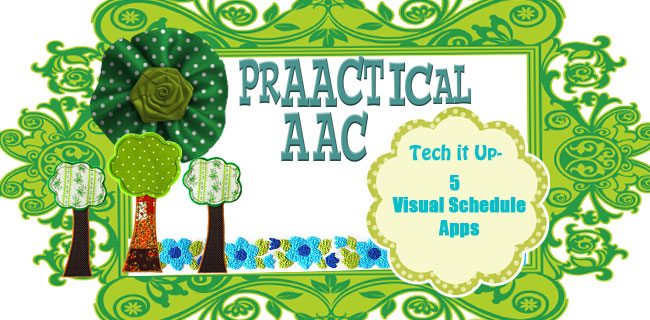
We have been writing a lot about schedules. Schedules can be created by using tools ranging from no-tech to high tech. Here are 5 great visual schedule apps to help with ‘teching’ up the process. We think it is important to let you know that ALL of the app developers provide information about the rationales behind schedules and visual learning which adds to our educated AAC consumers. One of our priorities in ‘blogging’ was to get the information about AAC systems and visual strategies out to more people with the hope that AAC systems will be provided to ALL cpeople who would need it It is great to see app developers prioritizing this as well. **Just 2 notes: for our own personal and business schedules we still use a combination of no-tech to high-tech options) and apps are listed in no particular order Choice Works $14.99 by BeeVisual + designed... [Read More...]
March 9, 2012
by Robin Parker -
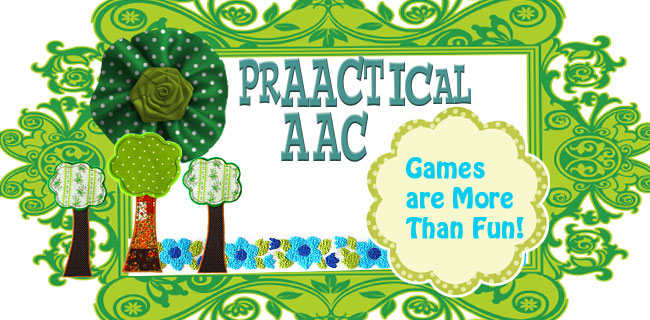
‘Gaming’- not something we typically associate with AAC, but we know that it is often the topic of conversation for kids, teens, and even adults, therefore, it is a topic that goes with AAC. Gaming can have a positive impact on socialization, interaction, communication, and inclusion associated with ‘gaming’. The gaming experience can be a topic of conversation before, during, and after the actual game experience. Gaming can be added to an activity schedule or on a choice board. A mini-schedule can be created to teach the steps to setting up a game, playing the game, or to invite a friend to game. Gaming is part of our pop culture (think Mario Brothers…). So we believe it should be an option if so desired. We would not be thought of as gamers. We have liked games and at times even loved them (think Astroids & Pac-Man), however we have not... [Read More...]









